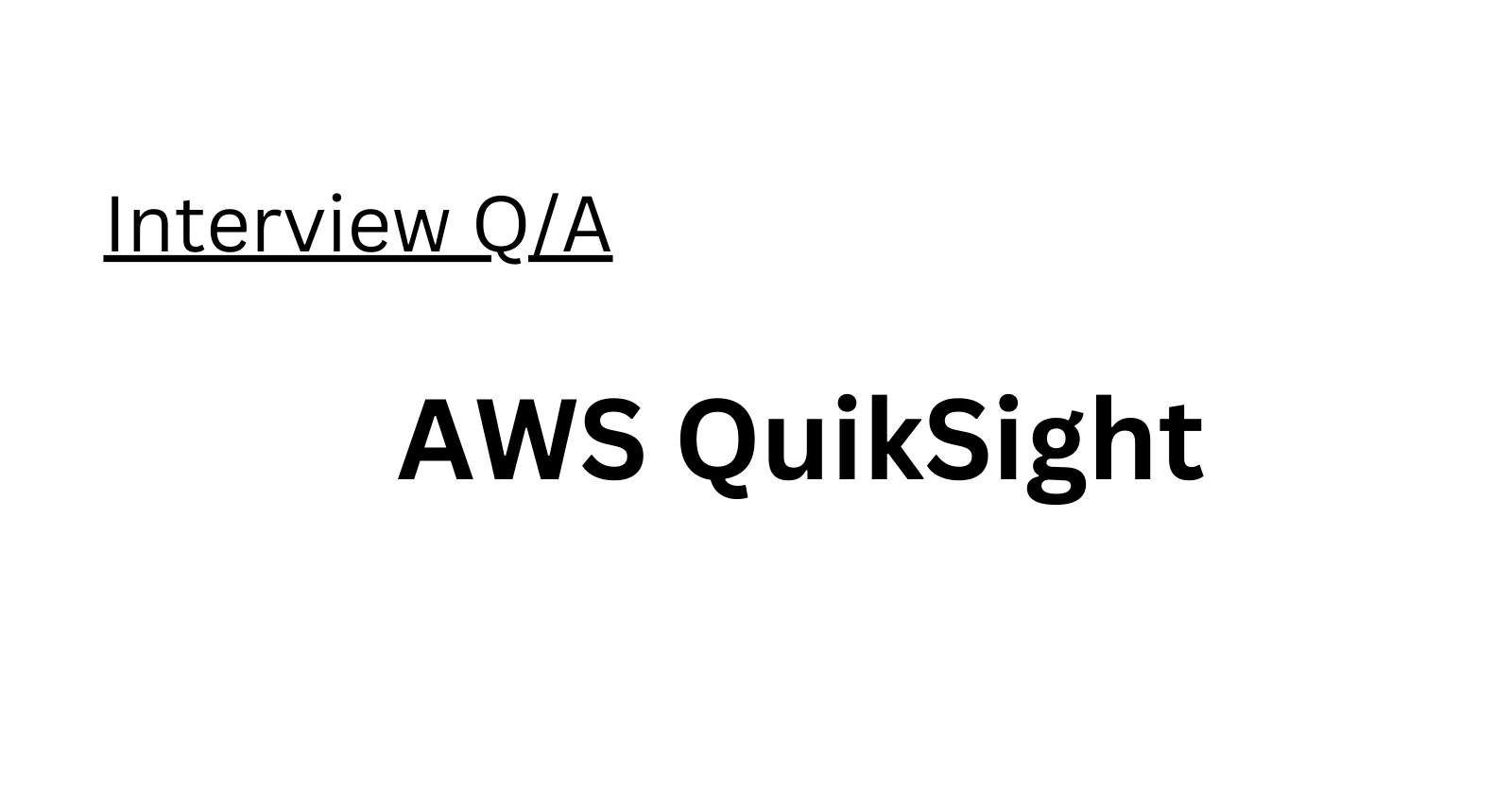AWS QuikSight Interview Q/A
 Amrutha D
Amrutha D
What is Amazon QuikSight?
Amazon QuickSight is a cloud-powered business intelligence service designed for easy data insight creation and sharing. It allows users to connect to various data sources, such as Amazon Redshift, Amazon RDS, and Amazon S3. QuickSight offers built-in visualization tools, pre-built dashboards, and custom dashboard creation. It comes in three editions: Standard, Enterprise, and Enterprise Plus.What are the main benefits of using Amazon QuickSight?
Amazon QuickSight offers several benefits, including fast and easy data visualization, collaboration and sharing capabilities, scalability, integration with other AWS services, and cost-effectiveness based on a pay-per-session model.Can you tell us about some common use cases for Amazon QuickSight? Amazon QuickSight can be used in various industries and applications, including financial analysis, sales and marketing analysis, operations and logistics optimization, human resources analysis, and healthcare data analysis.
How can you load data into Amazon QuickSight?
Data can be loaded into Amazon QuickSight by importing data from a file, connecting to a database, using data transfer services, employing ETL tools, or utilizing the QuickSight API for programmatic data loading.What does SPICE stand for in the context of Amazon QuickSight?
SPICE stands for "Super-fast, Parallel, In-memory, Calculation Engine," and it's the technology powering Amazon QuickSight's data visualization and analysis capabilities. SPICE is known for its in-memory architecture and parallel processing, enabling fast data processing.What are some advantages and disadvantages of using SPICE over other visualization tools?
Advantages of SPICE include fast performance, in-memory architecture, scalability, integration with AWS services, and cost-effectiveness. Disadvantages may include limited customization options, limited data transformation capabilities, and dependence on other AWS services.What is a dataset in the context of Amazon QuickSight?
In Amazon QuickSight, a dataset is a collection of data used to create dashboards, reports, and charts. Datasets can be created from various sources and shared with colleagues for collaborative data analysis.What's the difference between a dashboard and an analysis in Amazon QuickSight?
A dashboard in Amazon QuickSight provides a visual overview of key metrics and trends, while an analysis allows for in-depth exploration of specific questions or hypotheses, often involving filters, drill-downs, and calculations.What types of visualizations are available in Amazon QuickSight?
Amazon QuickSight offers various visualization types, including line charts, column charts, pie charts, bar charts, scatter plots, and heat maps, among others.Can you explain what Spark SQL is and how it relates to Amazon QuickSight? Spark SQL is a module of Apache Spark for structured data processing. In the context of Amazon QuickSight, Spark SQL is used to process and analyze data stored in Amazon S3 or other sources. QuickSight leverages Amazon Elastic MapReduce (EMR) Spark to provide access to Spark SQL without requiring users to set up and manage their own Spark cluster.
Can you give me examples of BI tools that can be integrated with Amazon QuickSight?
BI tools that can be integrated with Amazon QuickSight include Tableau, Microsoft Power BI, Looker, and Domo, among others.Is it possible to connect Amazon QuickSight directly to Snowflake Data Warehouse?
If yes, then how? Yes, you can connect Amazon QuickSight to Snowflake Data Warehouse by creating a user with the necessary permissions in Snowflake, configuring a data source in QuickSight, and selecting Snowflake as the data source type, providing the required connection information.What are the best practices when creating dashboards in Amazon QuickSight? Best practices for creating dashboards in Amazon QuickSight include starting with a clear goal, keeping dashboards simple, using appropriate visualizations, implementing filters and drill-downs, using templates, and testing and iterating for improvements.
What are some limitations of Amazon QuickSight?
Limitations of Amazon QuickSight include data size restrictions, limited customization options, limited data transformation capabilities, dependence on other AWS services, and potential cost considerations.When working with large datasets, what should I do to prevent performance issues while loading data into Amazon QuickSight?
To prevent performance issues when loading large datasets into Amazon QuickSight, consider using data transfer services, ETL tools, the QuickSight API, appropriate data types, and compressed data formats.Can you tell us more about the new features introduced in the latest version of Amazon QuickSight?
The latest version of Amazon QuickSight introduces features such as support for multiple languages, expanded data source connectivity, new visualization options, performance improvements, and bug fixes.Why would anyone need to use Amazon QuickSight instead of Tableau or PowerBI?
Amazon QuickSight offers cost-effectiveness, ease of use, and features designed for cloud-based data analysis, making it a compelling choice for organizations looking for quick setup, collaboration, and integration with AWS services.What is Super-Fast Parallel In-Memory Calculation Engine (SPICE) in context with Amazon QuickSight?
SPICE (Super-fast, Parallel, In-memory, Calculation Engine) is the in-memory data engine in Amazon QuickSight designed for fast data processing and analysis, using parallel processing and in-memory architecture.What steps are involved in connecting Amazon QuickSight to an external database?
To connect Amazon QuickSight to an external database, you need to have the necessary permissions, create a user in the external database, configure a data source in QuickSight, and provide connection details to establish the connection.How many levels of drill-down are supported by Amazon QuickSight?
Amazon QuickSight supports multiple levels of drill-down, allowing users to explore and analyze data in increasing detail, limited only by the data structure and analysis complexity.
Subscribe to my newsletter
Read articles from Amrutha D directly inside your inbox. Subscribe to the newsletter, and don't miss out.
Written by

Amrutha D
Amrutha D
Gen AI Video Creator | Gen AIOps | AIOps Cloud DevOps Engineer | Let's Connect & share Technical knowledge & grow together in Technologies Everyday..